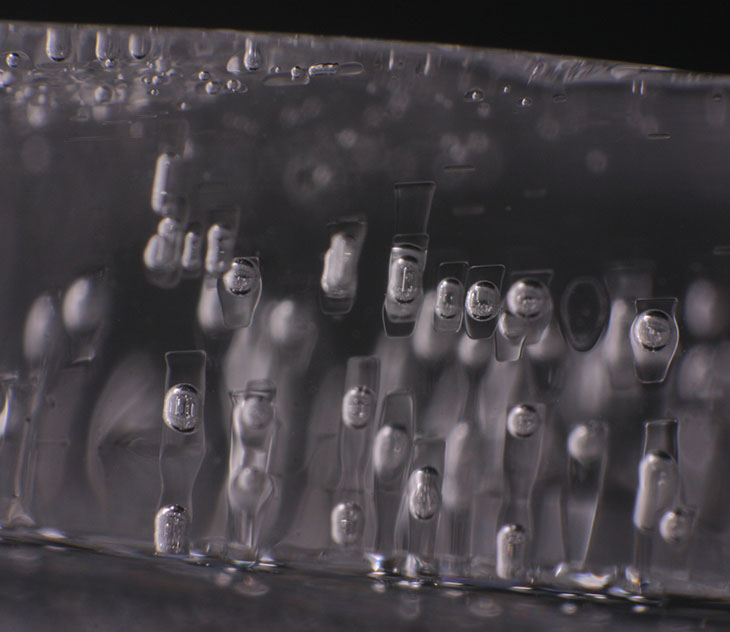
… but it’s better if you find it on your own.
North Carolina doesn’t really see ‘winter’ as many people imagine it – honestly, it’s pretty boring – but we do get cold spells from time to time, and went through one a few days back, after some heavy rains. Things that had collected water were frozen over, and in some cases nearly solid, so I took the opportunity to play around a little.
Above, what you’re seeing is… well, it’s hard to explain. On the underside of the thick surface ice in an old bucket were several thin blades of ice extending down into the water in these curious shapes. This particular image is of the removed ice, inverted and backlit by the sun at an angle that accentuated the contrast (and likely includes a certain level of polarization, if I’m interpreting it correctly.) Usually, I can look at some natural phenomenon like this and reason out what physics were at work, but these have eluded me. I wondered about different layers of water, with varying contamination or salinity perhaps, and these blades marked the levels between them, but that made no sense because they should have been parallel to the top surface. Ice had started down the inner sides of the bucket, close to freezing completely solid, but these blades weren’t parallel to the sides either. Worse, a couple of nice straight lines of them converged, laying over at different angles, completely trashing any ideas that they were dictated by the shape of the bucket or different qualities of the water.

The biggest clue, perhaps, is the bubble tracks nearby also follow the same angle, so my current guess is it had something to do with the ice expanding as it thickened, but that’s as far as I’ve gotten.

Bubble trails in ice aren’t too hard to comprehend. Gases (primarily oxygen and nitrogen) that release their bonds with water as the temperature and pressure change rise to the surface, but may be trapped under the ice. As they ice extends downwards, it forms around the bubble and eventually encapsulates it – the vertical expansion is what draws it out into elongated tubes as seen here. But it’s not always vertical, and some bubble trails form at odd angles to others, presumably due to differential expansion rates, though why this takes place I couldn’t say. In most of the cases I’ve photographed, leaves were present in the water and may have contributed to temperature differences; there’s also the possibility of residual heat from the sun having warmed one side of the vessels, or the wind causing greater cooling.

But then there’s this. This is a broken section of ice seen from the edge, a cross-section. The air bubbles are self-evident, but the shapes surrounding them? The appearance is of liquid water surrounding the gas bubbles and enclosed by ice, and my inclination is to see this as greenhouse heating, sunlight that penetrates the ice and warms the gases faster than the ice, but some of this heat is shed into the surrounding water and melts it. This doesn’t explain the flattened tops and bottoms of those channels (the tops I could see, since the air bubble might press against the flat underside of the initial ice layer,) so I’ll just leave it as, “damn if I know.”
I’ll close with another frost pic. This looks largely the same as previous images because that’s really all I’ve seen here so far; the conditions haven’t been right for much more than this, and almost every leaf in the immediate area is exactly the same, thanks to the oak tree that dominates the back yard. I admit to not dragging myself out at dawn to go down to the river for more variety – if someone wants better frost photos enough to pay for them, I can be motivated, but not for my own stock ;-). So I just go for the occasional attempt at an interesting approach, where I can go back inside to warm up easily.




















































